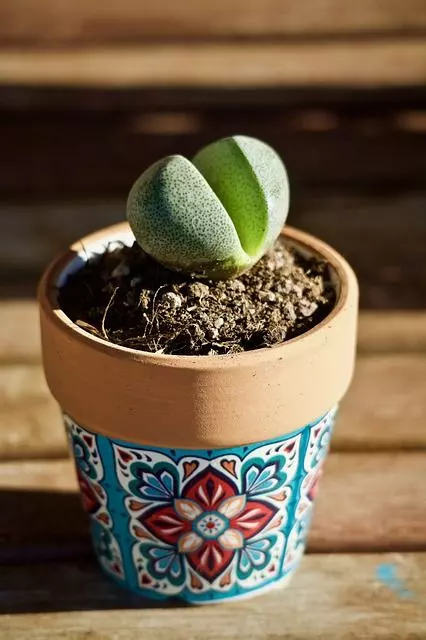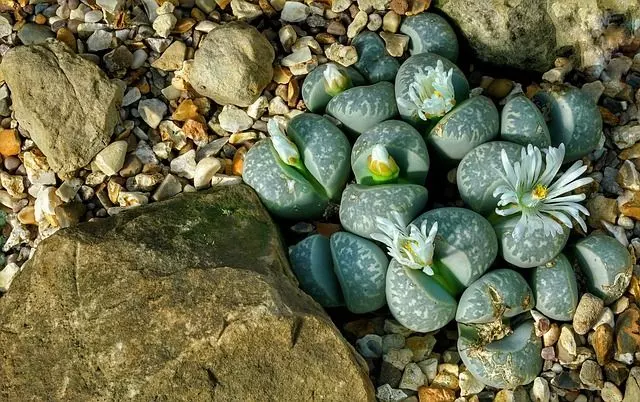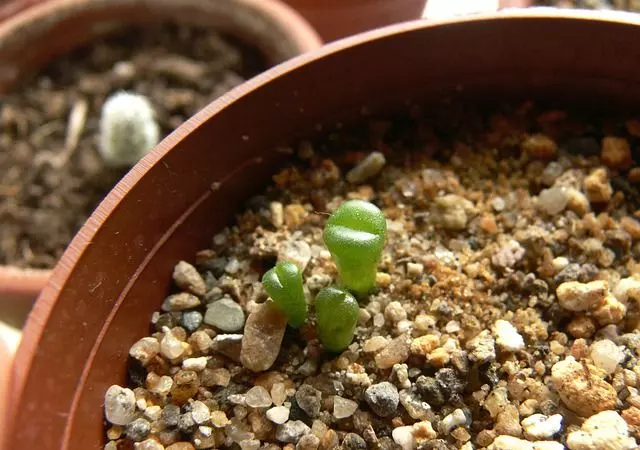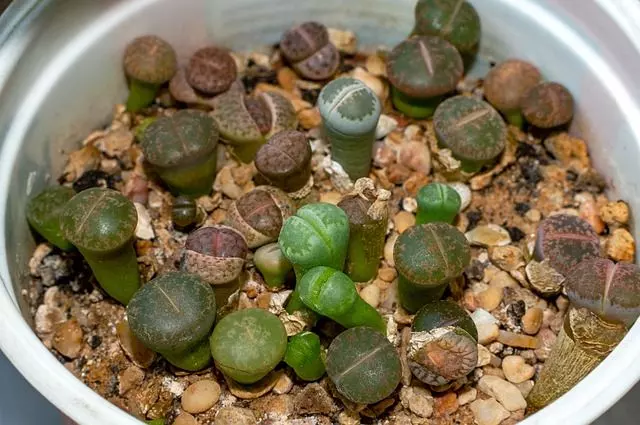Table of Contents
Learn How to Care for Lithops Succulent Plants
Lithops, commonly called “Living Stones” or “Stone Plants”, are succulent plants that developed an incredible mimicry to avoid being eaten by predators. Learn all about How to Care for Lithops in this article.
What are Lithops
Lithops are succulent plants and desert plants, native to South Africa, distributed in the hardiness zones 3-9. To avoid being eaten by predators, Lithops have developed an incredible mimicry, often impossible to distinguish among the stones on the ground.
Lithops plants have adapted to different soils, developing only two leaves attached to the base, opposite, fleshy, erect, semi-cylindrical, with a rounded end. The plant captures solar energy to carry out the chlorophyll function. At the end of winter, two new leaves are born in the center and grow at the expense of the nutrients of the leaves of the previous season, which gradually become stunted and die.

Lithops Living Stones
If you are wondering why Lithops are called Living Stones or Stone Plants, this refers to the way the plant has evolved to resemble a stone in its native area, the desert, to avoid being attacked by predators.
Lithops in the Wild
This succulent can be found in the wild, native to seasonally arid climates such as deserts, mountainous, or high rainforest tree limbs. Lithops developed fleshy leaves or stem capable of storing moisture. Lithops succulent plants are hardiness zones 3-9 unless otherwise noted.
In mild winter climates, these hardy plants are used as landscape specimens, foundation plantings, ground covers, and turf substitutes.
But in almost any part of the country, they can be planted in all types of containers, indoors or out, including wreaths and wall hangings.
Lithops bloom in late summer and autumn at the end of the day. Through the groove between the two leaves appear a bright yellow, white, orange, and pink flower.

How to Cultivate Lithops from Seeds:
Lithops can grow from seeds. To cultivating Lithops from seeds you need freshly harvested premium quality seeds, a substrate with a high percentage of sand (or perlite, or vermiculite), a germination cup, a water pipette, and cotton bedding. These elements will simplify designed to simplify the germination process. You can germinate the seeds anywhere you want in suitable conditions.
The seeds on the market show an excellent germination rate when they are fresh. Although be aware germination time could be different for each seed, but also each gardener. Be sure to maintain proper humidity, light, and temperature during the germination process. Allow air circulation in the germination cup, every day for a couple of hours and avoid direct sunlight.

Lithops seeds are extremely small and may be difficult to manipulate.
There is two germination method used for lithops cultivation: the cotton ball method and the soil method. Lithops seeds require much more attention than adult plants. Maintain medium humidity for the first 3 months.
- Exotic Lithops Seeds (Pack of 25) authentic seeds with High Germination Rate. Please be very careful when opening the seed vial, seeds are extremely small and can be easily blow away.
- A Bonus Live Mini Lithops Plant Is Included with the purchase. If you CAN'T find the bonus live plant, please check the soil inside the germination cup. Seeds germination rate various depends on the condition (Moisture, Light, Temperature, Air Circulation & Etc) It usually take 10-15 days to germinate, some seeds might take longer than others.
- A mini germination kit with instruction are included if you wish to watch them germinate closely before transplant into a regular pot.

Lithops Shriveling
Why my Lithops is Shriveling?
Why my Lithops is Wrinkling?
Lithops shrivel because of adverse growing conditions and water deficit. Watering is a key process for this plant. Shriveled lithops indicate that the plant was not regularly watered. It is important to water sparingly, perhaps just a few drops, but with the same basic frequency regularly. Many people mistakenly assume that because the plant is a cactus that it does not require water. However, this is more than incorrect. Both overwatering and underwatering affect Lithops. Lithops also shrivel when they are not watered directly into the soil. Water should enter through the roots, not through the leaves. That is why lithops should not be watered with a spray, but by giving water, even drop by drop, directly to the soil.
How to Care for Lithops
Lithops Care
How to Care for Lithops Lighting:
For good cultivation, it is necessary to respect the life cycle. The lithops behave according to the climate where we cultivate them, they respond to the amount of light received and the existing temperature.
It is better to place them in a place that gives them a lot of light, but not the direct sun in the afternoon.
How to Care for Lithops Watering
When to Watering Lithops
Lithops are desert plants, but they still need water throughout the year, even during the dormant stage. Water is needed to keep the root alive. Lithops indoors and outdoors need watering.
Watering depends on the weather. During Autumn a good watering every 10 days or so, when the sides of the plants show wrinkles that persist overnight. Lithops should be watering immediately after the plants shed their old leaves, and just before they flower in late summer or fall.
During early winter do not water at all, unless the plants appear to collapse drastically, or any fruit is visible. In late winter a little water every 20 days or so. On warm days.
Watering in early spring, one or two moderate waterings, especially if newly emerged leaves appear to be shriveled.
It is often advisable to mist lithops with water at night. They seem to respond to these sprays.
How to Watering Lithops
Do not spray water over the Lithops. Watering should be, even drop by drop, directly to the soil. Otherwise, the Lithops will be shriveled and wrinkled.
Lithops Splitting
When Lithops are splitting is part of a cycle life process of these plants. Depending on the Lithops growing season, sometimes lithops begin to split, crack, etc. Lithops may have scars on their sides and top. This is natural and does not mean your Lithops is dying. Lithops splitting is a natural process with lithops. Sometimes they just die. For no reason, it just happens. However, it is not related to the splitting process.
Rooting Lithops
Any disturbance of the roots will be responsible for burns on plants that are well lit. This fact will tell us how well-branched the fine lower roots are, as well as the plant’s ability to withstand heat and light.
Soil Mix for Lithops
Lithops needs a soil mix with a high percentage of sand, perlite, or vermiculite. Remember Lithops does not have a lot of roots. Commercial soil mix for cacti and succulent plants is the most appropriated for Lithops.
We hope that our guide to how to care for lithops be of great help to you.


